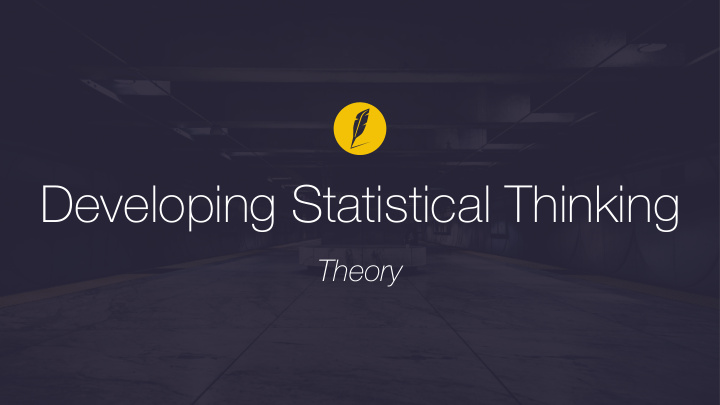



Developing Statistical Thinking Theory
My Thesis • Statistical Thinking is di ff erent from popular conceptions of mathematical thinking
Your Goal • Identify some issues demarcating statistical and mathematical thinking • Reflect on ways in which your teaching might change
Necessary Skills • Think • Manage yourself • Relate to others • Participate and contribute • Use language, symbols and texts
Equipment Needs • Paper • Pen • Highlighters (Optional)
00 Relate to others Each person will now tell the group four things: ๏ Your name (emphasise the pronunciation) ๏ Where you were born and where you currently live. ๏ Why you were interested in this workshop. ๏ Describe some ways in which learning statistics has been di ffi cult for students.
01 What is Statistical Thinking? Take a few minutes to think and write down your thoughts about what it means to think statistically
01 What is Statistical Thinking? Statistics is a method of inquiry (Moore, 1990) Statistics is a “discipline concerned with the study of variability, with the study of uncertainty and with the study of decision-making in the face of uncertainty ” (Lindsay et al, 2004, p. 388) Note: Teachers read Excerpt 1 from handout here
01 What is Statistical Thinking? 1 Dimension of Statistical Thinking from Wild & Pfannkuch (1999)
01 What is Statistical Thinking? 4 Dimensions of Statistical Thinking from Wild & Pfannkuch (1999)
01 What is Statistical Thinking? …We kind of follow the PPDAC kind of formula so it’s like a plan, purpose of plan, your data, analysis, conclusion – that’s what we use to write out our Stats reports. (Excerpt from Student Interview)
01 What is Statistical Thinking? “The situation is serious for elementary teachers who have little or no experience in this field, and often demonstrate little interest in mathematics although they have to teach it….” ( Gattuso & Ottaviani, 2011, p. 124)
01 What is Statistical Thinking? “…The situation is not much better for secondary teachers. Their mathematical knowledge is more important but in some ways, particularly if mathematics is seen in a formalistic view, this may even hinder their grasp of statistics….” ( Gattuso & Ottaviani, 2011, p. 124)
01 What is Statistical Thinking? “…Most trainee secondary teachers will follow a course in statistics but very few teacher training programmes include the didactic of statistics. In fact, mathematic educators often casually admit their lack of qualification in the subject.” ( Gattuso & Ottaviani, 2011, p. 124)
02 Developing Statistical Thinking Take five minutes to think and write down your thoughts about the following questions: ๏ What di ff erentiates mathematics and statistics? ๏ What are some of the obstacles for teaching Stats? ๏ What are some of the obstacles for learning Stats? ๏ What are some ways that you have overcome these obstacles?
02 Developing Statistical Thinking
02 Developing Statistical Thinking 1.The role of context; in statistics context provides meaning whereas in mathematics context provides the opportunity for applications [and] 2.The centrality of random variability or variability in data in statistics as opposed to the deterministic nature of mathematics (Burril & Biehler 2011, p. 59)
02 Developing Statistical Thinking In nearly all countries, statistics is not a separate school subject but is taught by teachers of mathematics, and training for teaching statistics occurs, if at all, as a catch-up in the form of professional development for practicing teachers. (Burril & Biehler 2011, p. 65)
02 Developing Statistical Thinking 1.Data 2.Variation* 3.Distribution 4.Representation 5.Association and modelling 6.Probability models 7.Sampling and Inference* (Burril & Biehler 2011, p. 59) Note: Teachers read Excerpt 2 from handout here
02 Developing Statistical Thinking 1.Certainty vs. Uncertainty 2.Statistics is a social construct and finds its meaning in context (Burril & Biehler 2011) (Gattuso and Ottaviani 2011) Note: Teachers read Excerpt 3 & 4 from handout here
02 Developing Statistical Thinking So what needs to be challenged at this point?
02 Some Ideas for Class
02 Some Ideas for Class Plot of Year 9 Female Heights and Armspans Plot of Year 9 Female Heights and Armspans 180 180 175 175 170 170 165 165 160 160 Height Height 155 155 150 150 145 145 140 140 135 135 130 130 130 135 140 145 150 155 160 165 170 175 180 130 135 140 145 150 155 160 165 170 175 180 Armspan Armspan
02 Some Ideas for Class
02 Some Ideas for Class Geogebra Investigation
03 Certainty and Uncertainty Is it correct that in Mathematics we are certain? Is it correct that in Mathematics we have objective truths? Is it possible to view mathematics as a social construct just like statistics? Note: Excerpt 5 extra reading for homework
04 Citations Burrill, G., & Biehler, R. (2011). Fundamental statistical ideas in the school curriculum and in training teachers. In C. Batanero, G. Burrill, & C. Reading (Eds.) (Vol. 14, pp. 57–69). Netherlands: Springer. Gattuso, L., & Ottaviani, M. G. (2011). Complementing mathematical thinking and statistical thinking in school mathematics. In C. Batanero, G. Burrill, & C. Reading (Eds.) (pp. 121–132). Netherlands: Springer. Lindsay, B. G., Kettenring, J., & Siegmund, D. O. (2004). A report on the future of statistics. Statistical Science, 19(3), 387–413. Moore, D. S. (1990). Uncertainty. In L. A. Steen (Ed.). Washington, D.C.: National Academy Press 1990. Wild, C. J., & Pfannkuch, M. (1999). Statistical thinking in empirical enquiry. International Statistical Review, 67(3), 223–248.
04 Other References Ernest, P. (1992). The nature of mathematics: Towards a social constructivist account. Science and Education, 1(1), 89-100. Ernest, P. (2016). The problem of certainty in mathematics. Educational studies in mathematics, 92 (3), 379-393 Sfard, A. (2001). There is more to discourse than meets the ears: Looking at thinking as communicating to learn more about mathematical learning.(Author abstract). Educational Studies in Mathematics, 46(1), 13.
Recommend
More recommend